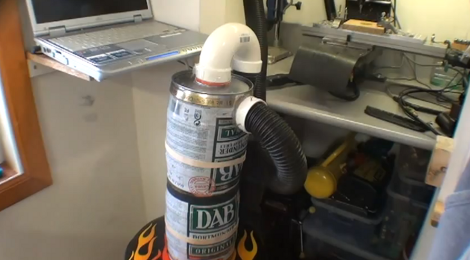
[Darrell] made his own cyclonic dust separator which connects to a shop vac. We’re amused by his poke at Dyson’s marketing machine where he mentions that the ads say it took years to perfect those vacuum cleaners and he managed to put his together in a few hours…. from trash/recyclables no less!
Two mini-kegs are used as the separating vessel. The only other parts are some PVC plumbing fittings which help to direct the air and give him a way to attach the collector to the shop vac. The top keg is where all of the magic happens. Air and debris is sucked in through the hose coming in the side wall. A 45 degree elbow directs it downward and to the side, which starts the cyclonic action. The shop vac is attached to the tube in the top, with a cylinder extending into the keg. The spinning air must make a sharp turn to get into that cylinder; it’s at this point the debris drops out into the lower keg. See for yourself in the clip after the break.
This isn’t the first time we’ve seen dust collectors that use this concept. [Darrell] pointed out this one made out of plastic cups, and this other made from a 5-gallon bucket.
[youtube=http://www.youtube.com/watch?v=yeMso1qAwWs*w=470]















Nice work! This was my take:
http://forums.hackaday.com/viewtopic.php?f=3&t=419&hilit=dust
The obvious problem with mine was that it has to be vented outside- the microscopic dust left over is the worst thing for your lungs.
Good point. Even if you don’t have dust issues now, they can creep up on you and become very serious.
Efficiency of 90% collection is pretty easy to achieve for the wood, plastic and metal chips/dust I deal with. A 5-gallon bucket and a few pieces of PVC pipe is a popular choice. High efficiency 5-gallon units are available for under $100.
My main collector is inertial, rather than cyclonic: A large-ish Y plenum (from the local HVAC supplier) directs the dust, carried by its own momentum downwards towards a 5-gallon bucket as the air slows down inside the cavity. A cheap “1hp” blower sits on top, with the output vented through a plexiglass window insert. Collection efficiency is surprisingly high, with very little dust accumulation in the secondary collection bag outside.
@Ken: What blower did you use? I’m looking for a way to increase the power of mine a bit.
Dave – I took the blower and collection bag from a Harbor Freight “1 HP Mini Dust Collector”.
I like your filterless take on a separator. I vent my shop vac outside if I am working on something really dusty.
The embed is broken, here is the url:
http://www.youtube.com/watch?v=yeMso1qAwWs
Double-check the video link.
Perfecting and doing good are two different things. Don’t brag about average and claim it’s perfect. The difference is a few hours versus a few years.
So average is more efficient, then.
Dyson went through *SO MANY* design iterations though. He didn’t just want a working vacuum cleaner. He wanted a PERFECT vacuum cleaner. That could be manufactured with injection molding and other high quantity low cost manufacturing techniques. I don’t believe it fair to say it took him years just to make a vacuum cleaner.
Agreed. Also, as far as I know Dyson came up with the original idea to use this type of system for vacuum (correct me if I’m wrong). A majority of engineering is coming up with the right idea and its implementation. Copying an idea/implementation is far easier.
Well he was the first successful one, but his real trick is that people believe he invented it, Apparently there was a patient out for it as early as 1928! http://en.wikipedia.org/wiki/Vacuum_cleaner#Cyclonic
Also I hate Dyson’s, all the fiddly little parts break, the plastic warps and the seals leak, and emptying them is disgusting. Give me a Henry or cheaper equivalent any day. Bags aren’t that bad!
Dyson absolutely did not invent the idea, but they did do a great job of marketing it as a new invention.
Kind of an obvious extension of the idea if you think about it. Cyclone separators have been used for nearly 100 years in the process industry.
Air + particles go in, air comes out, particles drop to the bottom. Kind of an obvious application for a vacuum cleaner if you think about it.
The trick is designing one to drop a large variety of dust types. In industrial applications cyclones are usually tuned to specific sized particles and thus often chained together in several stages in an attempt to drop out all the solids.
Given the light weight of dust particles, the small design of the vacuum cleaners, and the requirements to filter out a large variety of different particles efficiently Dyson really did achieve something.
Did he build this in a (man) cave?
The centrifugal forces will be increased, hence improving separation efficiency, if the inlet to his collector was tangential and not centered. The design now is more of a disengaging system than an actual cyclonic separator.
One aspect of Hacking is using what is “there” to make what is wanted or needed. This scores high for doing just that. Exploiting basic forces.
There’s several enhancements possible here. Using the metal of the kegs as electrostatic elements. A mist curtain with centrifugal dehumidification.
And, air-to-air heat exchangers for HVAC economy.
Now, paint the mini-kegs with the Duff beer logo.
Thanks for sharing this information about the mini barrels because many friends of mine were looking for it. Keep up the great work! I really appreciate it!